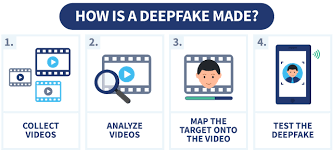Contents
- 1 Introduction
- 2 What are Deepfakes and the technology behind these Deepfakes?
- 3 What are the challenges being posed by Deepfakes?
- 4 How can Deepfakes be used for common good?
- 5 How can Deepfakes be tracked through the use of technology?
- 6 What is the status of Deepfakes regulation in India and across the world?
- 7 What should be the way forward?
- 8 What provisions should be included in a special legal framework dealing with Deepfakes?
| For 7PM Editorial Archives click HERE → |
Introduction
Deepfakes are back in news, after a video of actor Rashmika Mandanna has recently gone viral on social media. Responding to the video, Rajeev Chandrasekhar, the Union Minister for Electronics & Technology, has said that deep fakes are the latest and a “more dangerous and damaging form of misinformation” that needs to be dealt with by social media platforms.
While raising serious concerns over such videos, the Hon’ble Prime Minister also recently flagged a deepfake video of him doing Garba.
Ministry of Electronics and Information Technology (Meity) has sent notices to “all social media intermediaries” like Facebook, Youtube and Instagram, reminding them that online impersonation is illegal under Section 66D of the Information Technology Act, 2000. The Ministry has warned these platforms to take down such content within 24 hours, a requirement which has been outlined in the IT Rules, 2021.
What are Deepfakes and the technology behind these Deepfakes?
Deepfakes- Deepfakes are fake content in the form of videos, pictures and audio which are created using powerful artificial intelligence tools. The origin of the word “deepfake” can be traced back to 2017 when a Reddit user, with the username “deepfakes”, posted explicit videos of celebrities.
Technology used behind these deepfakes-
(1) The technology involves modifying or creating images and videos using a machine learning technique called generative adversarial network (GAN). This AI-driven software detects and learns the subjects’ movements and facial expressions from the source material and then duplicates these in another video or image.
(2) To ensure that the deepfake created is as close to real as possible, creators use a large database of source images. This is why more deepfake videos are created of public figures, celebrities and politicians.
(3) The dataset is then used by one software to create a fake video, while a second software is used to detect signs of forgery in it. Through the collaborative work of the two software, the fake video is rendered until the second software package can no longer detect the forgery. This is known as “unsupervised learning”, when machine-language models teach themselves. The method makes it difficult for other software to identify deepfakes.

What are the challenges being posed by Deepfakes?
(1) Promotes ‘Liar’s Dividend’- Liar’s Dividend refers to the situation when an undesirable truth is dismissed as deepfake or fake news. Leaders weaponise deepfakes to replace an actual piece of media and truth. Ex- Donald Trump Deepfake videos. Deepfakes blur the line between reality and fake. People start dismissing reality as fake.
(2) Erosion of trust in democratic processes like elections- Doctored content, most likely in the form of a realistic fake video is presented as fact to alter public perception and create democratic deficit. For Ex- Capitol Hill violence, 2021 was incited by using deep fake media.
(3) Crime against women- The deepfakes are being used as a weapon to attack women dignity and chastity. According to AI company Deeptrace report, over 90% of the deepfake videos are pornographic in nature.
(4) Fuelling Radicalisation and violence- The non-state actors like ISIS and Al-Qaeda, use fake videos to stir anti-state sentiments among people. For Ex- Fake videos showing armed forces committing ‘crimes in conflict areas’.
(5) Rise in cyber crimes- Cyber criminals are using deepfake technology to carry out phishing attacks, financial frauds and identity theft. Researchers have observed a 230% increase in deepfake usage by cybercriminals and scammers. For Ex- CEO of a U.K. energy company was tricked using deepfake audio to transfer €2,20,000 to fraudsters.
(6) Means of ‘hybrid warfare’ or ‘grey zone tactics’- Countries have been using the deepfakes to spread misinformation and for espionage. European Union has termed these deepfakes as ‘Foreign Information manipulation Interference‘. For Ex- China has been employing deepfakes of injured Indian Soldiers by the PLA Army.
(7) Trust deficit in traditional media- Even mainstream news sources often
fall for the propagandist misinformation which enhances trust deficit in these media channels. For Ex- Morphed video of Zelensky asking his soldiers to surrender was widely played on main stream media.
However, as we know that technology is a double-edged sword, there are also some benefits associated with deepfake technology.
How can Deepfakes be used for common good?
(1) Use in the field of creative art and Entertainment- The deepfake technology can be used to improve the dubbing on foreign language, films and resurrect dead actors. For ex- Samsung artificial intelligence lab in Moscow has brought Monalisa to life by using deep fake technology.
(2) Voice restoration- The technology has been used to restore the voices of patients suffering from amyotrophic lateral sclerosis. Various ‘Voice cloning initiatives‘ have been launched.
(3) Creating empathy for people of War torn regions- Projects like the Deep empathy project of MIT and UNICEF has been increasing empathy for victims of a disaster region by creating AI-images of war-torn regions like Syria, Yemen.
How can Deepfakes be tracked through the use of technology?
1. IP address Tracking: It involves tracking the unique identifying number assigned to every device connected to the internet.
2. Open-Source Intelligence (OSINT): The process of gathering and analyzing information from public sources to answer a specific question.
3. Metadata Analysis: Metadata is data that describes other data. It can help identify factors such as when a file was created, and where or when a document was last modified.
4. Facial Recognition Technique: It can analyze discrepancies in facial features or movement inconsistencies that deviate from natural human behavior or structures.
5. Content Recognition Algorithms: They can detect irregularities in audiovisual elements such as unnatural alterations, discrepancies in facial expressions, or anomalies in contextual details.
What is the status of Deepfakes regulation in India and across the world?
| India | (1) India does not have specific laws or regulations that ban or regulate the use of deepfake technology. (2) Sections 67 and 67A of the Information Technology Act (2000) related to defamation and publishing explicit material is applied in cases of deepfakes. (3) India’s IT Rules, 2021 require that all content reported to be fake or produced using deep fake be taken down by intermediary platforms within 36 hours. Sections 66C (identity theft) and 66E (privacy violation) of the IT Act, 2000 also can be applied. (4) Section 500 of IPC also provides punishment for defamation. (5) Section 292 of IPC (obscene content), Sections 465 (forgery) and 469 (harming reputation) of IPC. |
| US | The U.S. introduced the bipartisan Deepfake Task Force Act to assist the Department of Homeland Security (DHS) to counter deepfake technology. |
| EU | (1) European Union has updated Code of Practice on Disinformation that was introduced in 2018 to stop the spread of disinformation through deepfakes. (2) The EU has issued guidelines for the creation of an independent network of fact-checkers to help analyse the sources and processes of content creation |
| China | China has introduced Comprehensive Regulation on Deep Synthesis aimed at curbing disinformation. |
What should be the way forward?
(1) Responsibility of social media intermediaries- Social media intermediaries have to develop technology to detect and report deepfakes on their sites like watermarking AI-generated content. For Ex- Microsoft’s video authenticator is a new anti-deep fake technology to fight misinformation.
(2) Blockchain-based Deepfake Verification- The use of blockchain technology for media creation will allow the individuals to trace the origin and modification history of media. This will discourage the creation and dissemination of malicious deepfakes.
(3) Digital India Act- The forthcoming Digital India Act must have penal provisions in case of malicious deepfakes. India must take lessons from China’s comprehensive regulations on deepfakes.
(4) Public awareness and responsibility- Social awareness about the menace of malicious fake videos must be promoted. The public must be made aware of ‘Pause, think and share‘ principle for social media.
(5) Implementing the principles of Bletchley Declaration- The declaration calls to address risks and responsibilities associated with frontier AI like deepfakes. India, which is amongst the signatories must take a lead in finalising the global AI regulatory framework, in accordance with the declaration principles.
What provisions should be included in a special legal framework dealing with Deepfakes?
Clear Definitions: A legal framework for deepfake videos should include a clear definition of what exactly constitutes a deepfake.
Prohibitions Against Misuse: Prohibition on certain uses of deepfake videos, such as using them to commit fraud, impersonate others, or interfere with elections.
Timely Redressal: A significant challenge with Deepfakes lies in the rapid dissemination of these videos. Establishing an active watchdog mechanism is imperative since courts tend to operate at a slow pace.
Involving Social Media Platforms: They should be required to take steps to detect and remove deepfake videos in a time bound manner.
Legal Remedies: Victims of deepfake videos should also have the ability to seek legal recourse from the creators and distributors of the videos.
Protection for Minors: Deepfakes may contribute to severe consequences, particularly when it involves minors who may be driven to take extreme measures.
Protecting the Rights of the Artist: It is important to balance the rights of artists for fair use. General principles such as copyright and the right to privacy of the artist can be applied.
Read More- Bletchley Declaration
| Read More- Indian Express 1, Indian Express 2 UPSC Syllabus- GS III- Awareness in the fields of IT |
Discover more from Free UPSC IAS Preparation Syllabus and Materials For Aspirants
Subscribe to get the latest posts sent to your email.







